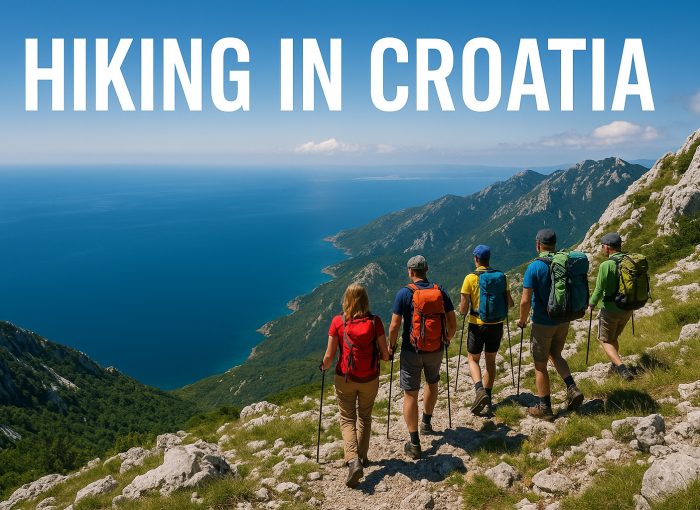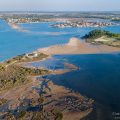Discover hiking in Croatia, on scenic coastal mountains, and marked trails—even without alpine peaks, nature here will take your breath away.
Even without towering alpine peaks or snowcapped giants, Croatia is a hiker’s paradise. Its charm lies not in altitude, but in attitude—a deep-rooted tradition of exploring wild mountain paths, coastal ridges, and forested valleys. Hiking in Croatia is one of the most beloved outdoor activities, with thousands of kilometres of marked trails weaving through national parks, remote villages, and dramatic limestone ranges that rise above the Adriatic Sea.
Table of Contents
What Croatia lacks in glacial drama, it makes up for with untamed beauty, panoramic views, and a sense of peaceful solitude. While mountain huts and shelters here are often simple, the rewards—sunrises over the sea, wildflower-strewn meadows, and eagle’s-eye vistas—are anything but. Whether you’re after a gentle hill walk or a multi-day trek along rugged karst slopes, Croatia invites you to lace up your boots and wander where the WiFi ends.
Croatian Mountains
Croatia’s mountains are largely part of the Dinaric Alps, a rugged range defined by limestone terrain and dramatic karst formations. Over time, weathering and the partial solubility of calcite in water have shaped the limestone into a porous landscape known as karst (or krš in Croatian). This terrain rarely holds surface water, making springs and rivers scarce—but when they do appear, they often form lush, green oases in otherwise barren surroundings.
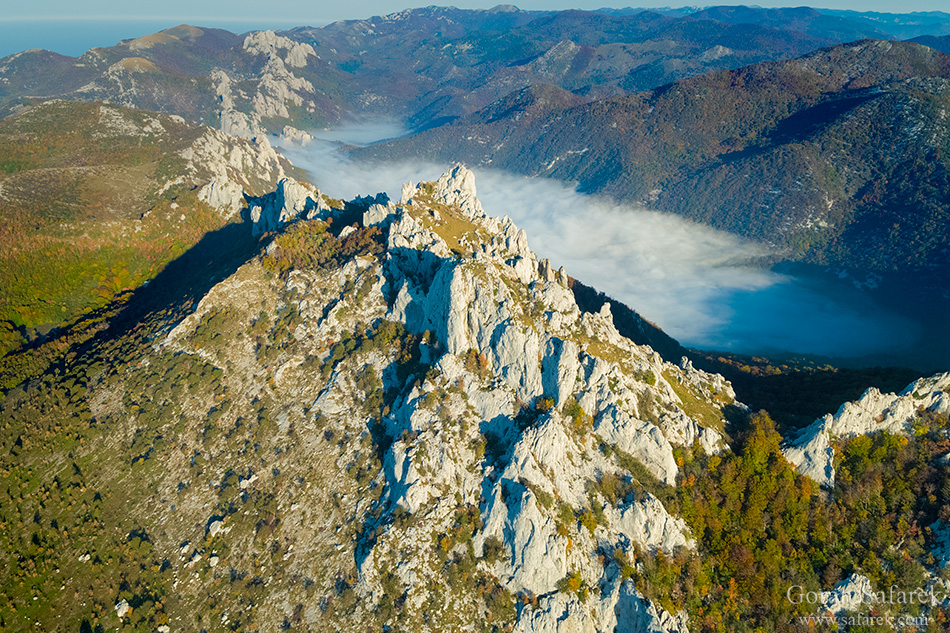
Croatia doesn’t boast towering peaks; its highest summit is Sinjal (1,831 m) on Mount Dinara near Knin. These relatively modest altitudes, combined with the karst geology, mean you won’t find classic alpine scenery here. But that doesn’t make the Dinaric range any less captivating.
Quite the opposite.
The Dinarics are celebrated for their microrelief, raw beauty, and untamed wilderness. Here, jagged ridges and hidden valleys give home to iconic wildlife such as lynx, bears, and wolves—a testament to how wild these lands still are.
Further inland, Croatia’s continental hills and low mountains stand apart. Older and shaped by metamorphic and volcanic rock, they rise from the plains like solitary islands. Though smaller and less dramatic, they add rich geological and ecological diversity to the country’s mountainous profile.
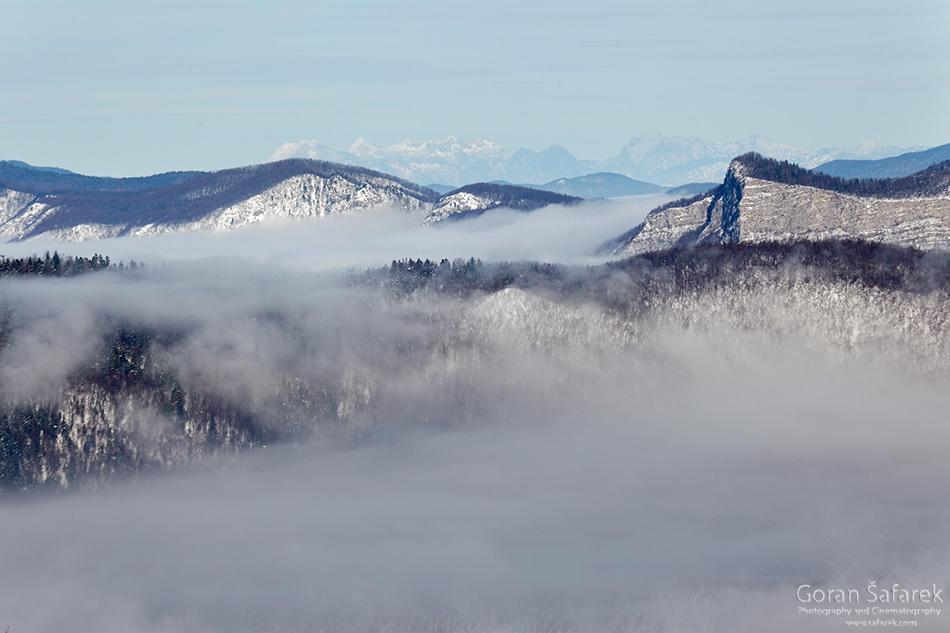
Gear for Hiking in Croatia
While Croatia’s mountains aren’t high by alpine standards, don’t be fooled by the modest elevations—conditions can still be demanding, especially in the coastal ranges. The Velebit and other Dinaric mountains are exposed to sudden weather shifts, high humidity, heavy snowfalls, and the fierce bora wind, which can make even a casual hike feel like a true adventure.
That said, technical climbing gear is rarely necessary. For most hikes, standard trekking equipment will do just fine—sturdy hiking boots, layered clothing, weather protection, and plenty of water.
In winter, however, some extra precautions are essential, especially in the exposed coastal mountains:
- Crampons are strongly recommended for trails on Velebit and similar ranges, where daily freeze-thaw cycles create a hard, slippery crust of ice.
- On certain summits, like Sveto Brdo, an ice axe may also be needed for safety, particularly when tackling steep or icy slopes.
For most of the year, though, hiking in Croatia is refreshingly low-tech—wild, beautiful, and simple.

Dangers & Safety Tips
Hiking in Croatia is generally safe and beginner-friendly, with well-marked trails and no need for technical climbing skills in most areas. However, this shouldn’t lead to complacency—nature here is still wild, and every year the mountains sadly claim lives.
One of the biggest dangers is underestimating the terrain. Too often, hikers head out in flip-flops, shorts, and t-shirts, thinking it’s just a casual stroll—only to find themselves lost, injured, or caught in rapidly changing weather conditions. The Croatian Mountain Rescue Service (HGSS) is frequently called into action, sometimes deploying helicopters to assist stranded or unprepared hikers.

HGSS operates not only in the mountains, but also along rivers, gorges, cliffs, and remote nature areas. If you ever find yourself in trouble, the emergency number to call is 112—available 24/7 across the entire country.
So while the Croatian mountains may not demand ropes and harnesses, they do require respect, awareness, and proper preparation.
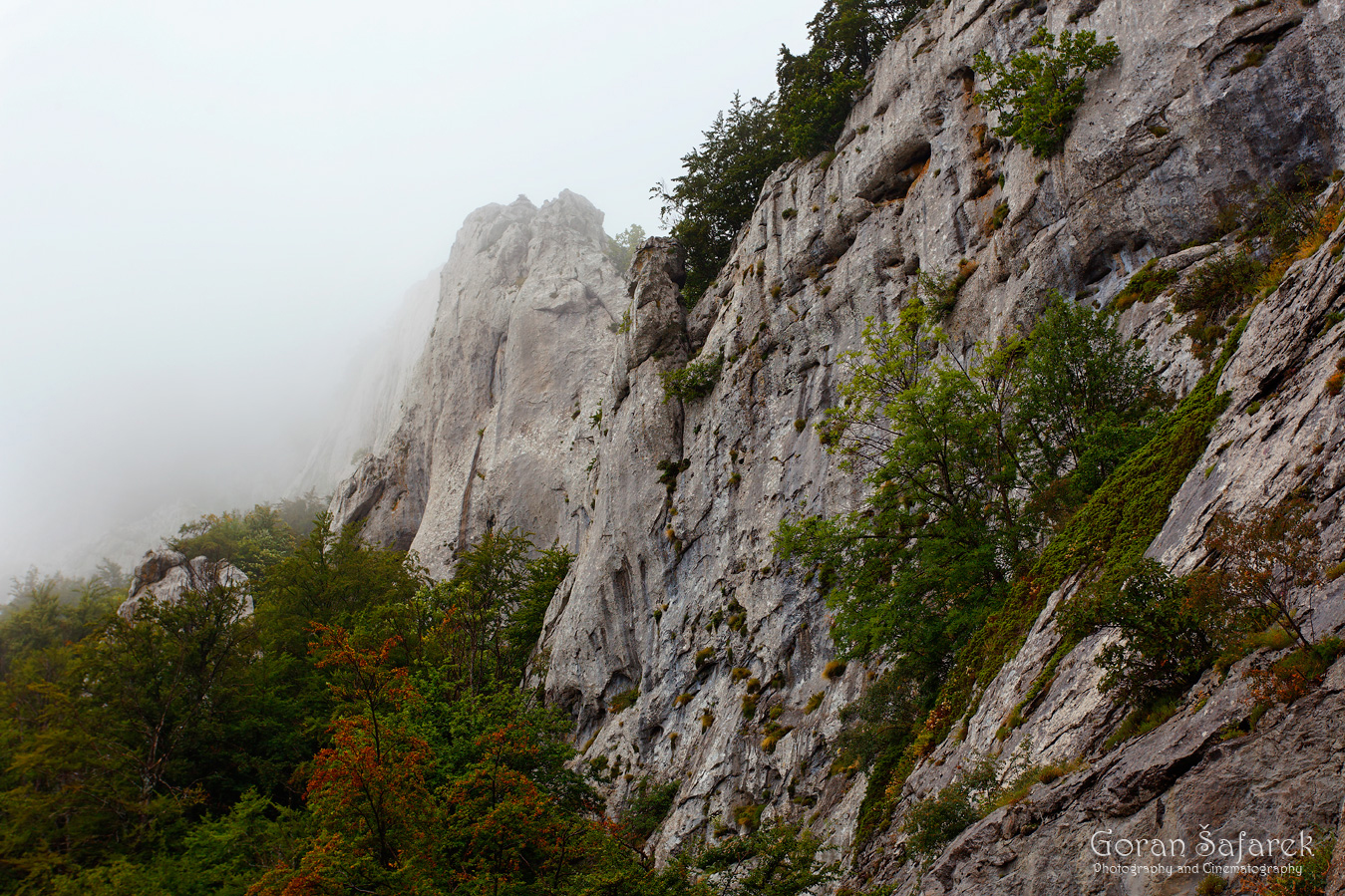
When to Hike: Seasons in Croatia
Hiking in Croatia is possible year-round, thanks to its relatively mild climate and diverse landscapes. However, each season brings its own conditions and considerations.
Most foreign tourists hit the trails in summer, when the weather is stable and sunny—but this is also the driest time of year, especially in karst regions where surface water is already scarce. Streams may dry up completely, so it’s essential to carry enough water.
For experienced hikers or those seeking the best of both weather and scenery, the ideal times are:
- Late spring (May to June) – Lush greenery, blooming wildflowers, and mild temperatures.
- Late summer to early autumn (September to October) – Pleasantly warm, fewer crowds, and golden landscapes.
Winter hiking is also possible, particularly in the coastal mountains, though trails can be icy and require appropriate gear like crampons and ice axes.
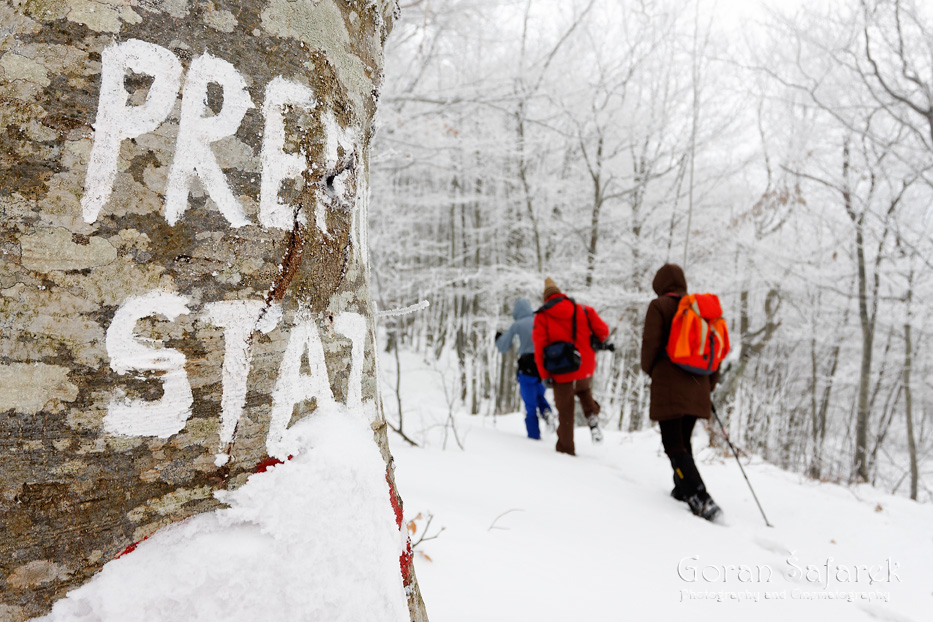
Costs of Hiking in Croatia
One of the best things about hiking in Croatia is that it’s affordable and accessible. Most trails are free to use, and even those in protected areas are budget-friendly.
If you’re exploring national parks like Sjeverni Velebit or Paklenica, you’ll need to pay an entrance fee, typically ranging from €5–€10, depending on the season.
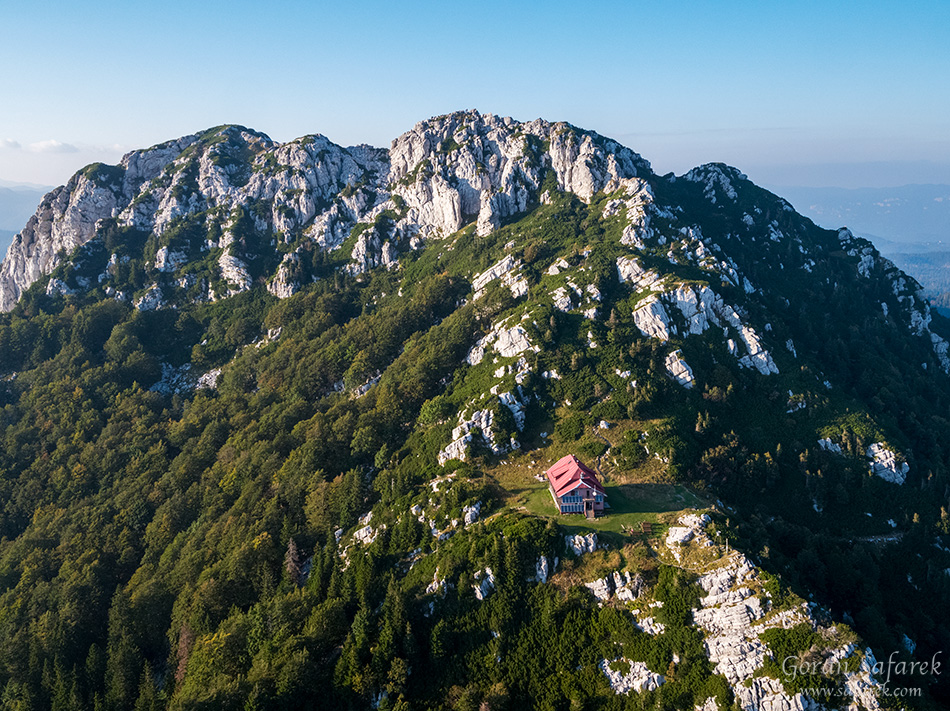
For overnight stays, mountain huts (planinarski domovi) are scattered throughout the country and offer rustic but cozy shelter. Prices are usually between €10–€15) per night. Members of the Croatian Mountaineering Association (HPS) receive a 50% discount, and international hiking club cards are often accepted too.
Mountain shelters (skloništa) are even more basic—often unmanned, with minimal facilities—but free to use. They’re perfect for emergency overnights or minimalist adventurers.
So whether you’re planning a day hike or a multi-day trek, hiking in Croatia is a low-cost, high-reward experience.

Where to Hike in Croatia?
Gorski Kotar: The Green Heart of Croatia
Tucked between the Kvarner Gulf, Slovenia, and the Lika highlands, Gorski Kotar is one of Croatia’s most underrated hiking regions. Though built on karst rock like much of the country, this mountainous zone is blessed with abundant rain and snow, making it unusually lush and forested. Towering firs, beech forests, and alpine meadows dominate the landscape, making it a dream for nature lovers seeking peace, shade, and clean mountain air.
The main hub is Delnice, but trails span the entire region.
🌲 Risnjak National Park
- Highest peak: Risnjak (1,528 m)
- Why go: Spectacular panoramic views stretching to the Alps, well-maintained mountain hut, and a network of scenic trails
- Trailheads:
- Crni Lug – The main national park entrance, a longer route through dense forest
- Gornje Jelenje – A shorter but steeper approach from the historic Zagreb–Rijeka road
- Winter Tip: One room in the Risnjak hut remains open year-round, equipped with a stove—ideal for snow-season shelter
🏔 Snježnik (1,506 m)
A fantastic day hike offering sweeping views of the surrounding peaks and the sea. Unfortunately, the mountain hut is abandoned, so it’s not suitable for overnight stays—but well worth the trek for a daytime escape.
🧭 Burni Bitoraj (1,386 m)
This lesser-known peak lies between Lokve and Fužine, and offers a wild, peaceful hiking experience. The trail leads through thick conifer forests and karst clearings, with occasional views over Gorski Kotar and the distant sea.
A modest but well-maintained shelter (Bitoraj Planinarsko Sklonište) sits just below the summit, providing protection from the elements. It’s equipped with a wood stove, mattresses, and basic seating, making it a great stop for overnight hikers or just a warm rest spot.
Perfect for those seeking quiet solitude and off-the-beaten-path adventure.
⛷ Platak & the Obruč Range
Further down the old Zagreb–Rijeka road, you’ll find Platak, a modest ski resort in winter and a fantastic hiking base in warmer months. From here, trails lead to the Obruč range, with open grassy ridges, wide horizons, and dramatic views over the northern Adriatic coast. A solid mountain hut at Platak makes this area great for weekend trips year-round.
🏞 Bijele Stijene & Samarske Stijene: Gorski Kotar’s Wildest Corners
On the eastern edge of Gorski Kotar, the landscape becomes truly surreal. Here lie Bijele stijene (“White Rocks”) and Samarske stijene—two of the most dramatic and beloved hiking destinations in Croatia.
Carved by wind, water, and time, these limestone formations rise like gleaming white towers from dense forests. The terrain is a raw, rugged wonderland, almost entirely untouched by human hands. So wild and pristine, the area is protected as a strict nature reserve.
A network of marked trails weaves through the region, leading hikers across ridges, down narrow crevices, and through hidden karst basins. The terrain can be tough—expect scrambling, steep drops, and sudden shifts from sunlit rock to icy shade. In some sheltered spots, snow lingers well into late spring.
- On Bijele stijene, you’ll find a mountain hut (planinarski dom) and a nearby shelter, both offering refuge for overnight hikers.
- Samarske stijene features one of the most atmospheric shelters in the country: a tiny wooden hut tucked into a dramatic rock crevice, surrounded by vertical cliffs and absolute silence.
- For those coming from Fužine, nearby Burni Bitoraj offers another shelter and serves as a scenic promontory with open views.
These peaks aren’t just hikes—they’re an immersion in Croatia’s most dramatic wilderness.
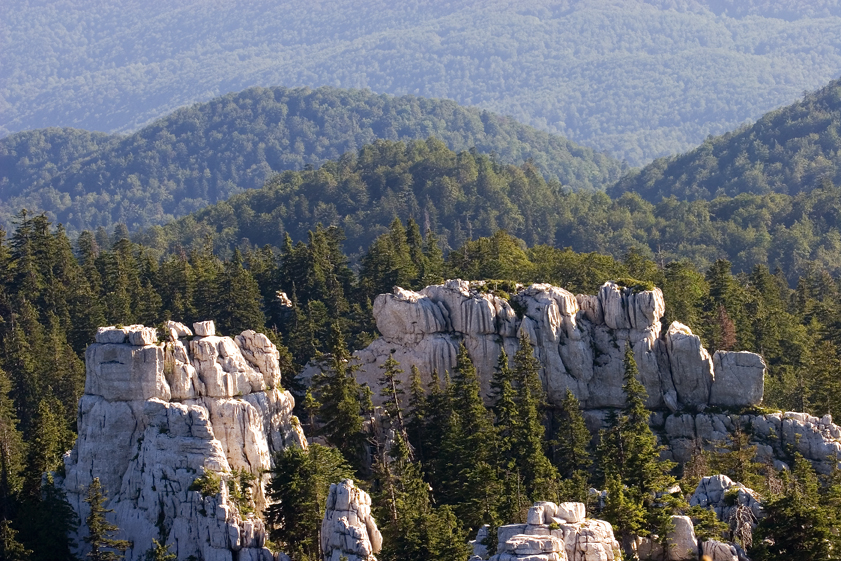
Učka: The Viewpoint of the Kvarner Riviera
Rising to 1,401 meters, Učka Mountain towers above the elegant seaside town of Opatija and the sparkling Kvarner Gulf. While the mountain itself isn’t particularly rugged or technically challenging, it remains one of the most popular day hikes in western Croatia—thanks to its spectacular panoramic views and easy access from coastal destinations in Istria and Kvarner.
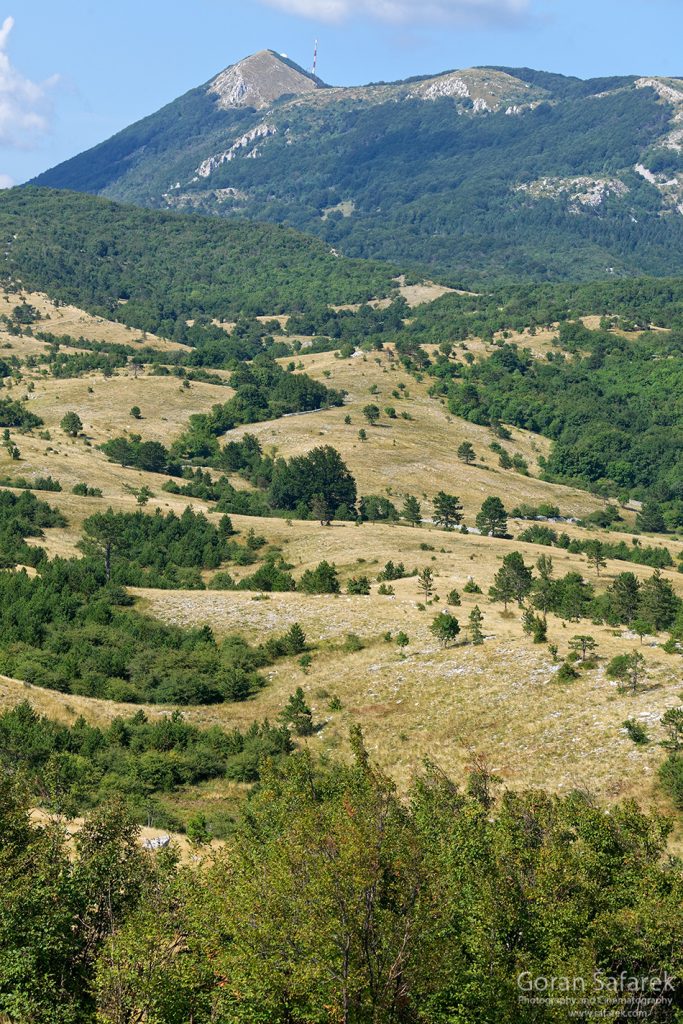
The highest peak, Vojak, is crowned with a stone observation tower, from which you can gaze across the Istrian peninsula, the Kvarner islands, and on clear days, all the way to the Julian Alps and Italy’s Dolomites.
But Učka’s surprises don’t end at the summit.
On the western slopes lies the dramatic Vela Draga canyon, a true geological wonder. Here, limestone towers and spires rise like natural cathedrals—formed over millennia by erosion. The area is protected as a geomorphological natural monument, and a well-maintained educational trail leads to several viewpoints overlooking the fantastical formations. It’s also a favorite among rock climbers and geology lovers.
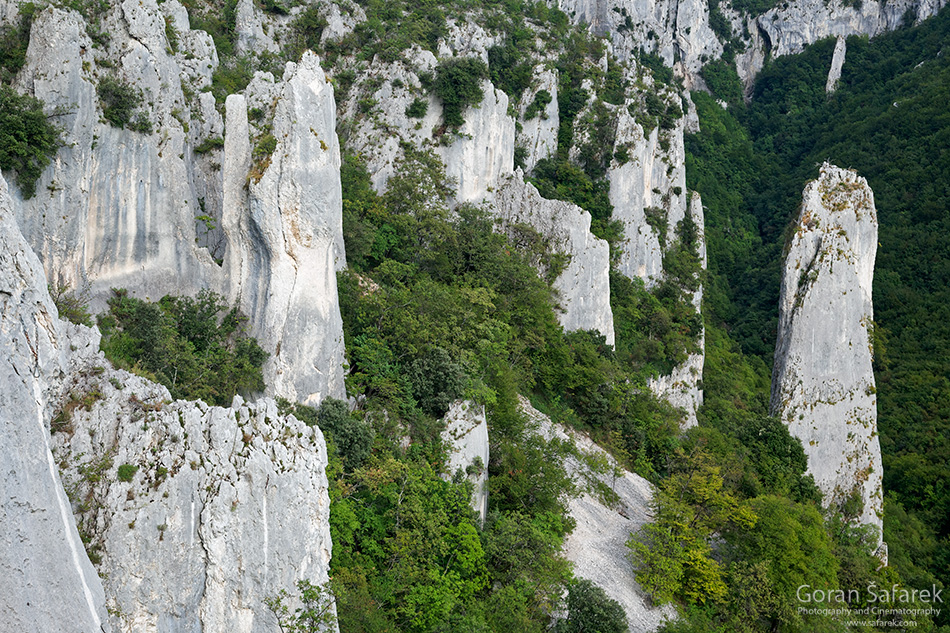
- Why hike it: Stunning 360° views, proximity to tourist hubs, accessible trails
- Trailheads: Lovran, Vela Učka village, or Poklon Pass (easiest route)
- Facilities: Mountain hut at Poklon, parking, info center, and refreshments in season
- Best for: Casual hikers, photographers, and travelers based in Opatija, Rijeka, or Istria looking for a rewarding half-day hike
Though not as wild as Velebit or as mysterious as the Gorski Kotar ranges, Učka offers a different kind of reward—views that stretch for miles, with the sea glittering beneath your feet.
🏞 Velebit: Croatia’s Most Iconic Mountain Range
Stretching like a limestone spine above the Adriatic coast, Velebit is Croatia’s most legendary and diverse mountain range—and undoubtedly its top hiking destination. No other region matches its dramatic contrasts: wild karst towers, lush valleys, sweeping coastal views, and deep canyons. The entire mountain is protected as part of the UNESCO Biosphere Reserve, and two national parks—Northern Velebit and Paklenica—safeguard its most spectacular areas.
Northern Velebit: Zavižan & the Premužić Trail
The heart of Northern Velebit is Zavižan, home to a charming mountain hut and meteorological station, famously run by Ante Vukušić. From Zavižan, views stretch in all directions—to the sea, to the inland forests, and to the stark limestone peaks that make Velebit so iconic.
- Getting there: Reachable by foot from Krasno, Oltari, or directly by car from Krasno
- Highlights:
- Velebit Botanical Garden – A glimpse into the mountain’s incredible plant diversity, including endemic species
- Premužić Trail – A legendary 57 km trail engineered in the 1930s, following the contours of the mountain with minimal ascents, making it perfect for all skill levels
Suggested 4-day route:
- Zavižan → Rossi Shelter – Easy start through rich pine forests and rocky overlooks
- Rossi Shelter → Alan Hut – Jaw-dropping views of the Hajdučki and Rožanski kukovi—craggy limestone towers that feel like another planet
- Alan Hut → Ograđenica Shelter → Baške Oštarije – Rolling meadows, ancient forests, and remote solitude
- Dabarski Kukovi side loop – A full day exploring Godzilla-like limestone ridges; Bačića Kuk is a renowned climbing spot
💧 Important: Shelters are scenic but lack water—fill up at mountain huts.
🛌 Stay at the newly opened hostel in Baške Oštarije for comfort after your trek.
🏔 Southern Velebit: Vaganski Vrh & Sveto Brdo
The southern section is Velebit’s highest and most alpine-like, with extensive grasslands, sweeping ridgelines, and Croatia’s tallest peaks:
- Vaganski Vrh (1,757 m) – Highest peak in Croatia
- Sveto Brdo – Just slightly lower but often preferred for its dramatic profile and views
Shelters along the way make it possible to spend several days trekking through this remote region.
🏞 Paklenica National Park: Where Mountains Meet the Sea
The Paklenica canyons slice through the southern face of Velebit like deep gashes, carved by water over millennia. This is one of Croatia’s most famous climbing and hiking areas.
- Velika Paklenica – The main canyon, home to the iconic Anića Kuk, a 300 m climbing wall
- Paklenica Stream – Permanent water source with rapids, cascades, and boulders, followed by a well-marked trail from the sea to the summits
- Mala Paklenica – A tougher, narrower canyon, less traveled and more wild
- Paklenica Hut – Good base for exploring the upper sections and tackling Vaganski Vrh
⛰ Tulove Grede: Spires at the Edge
On the southeastern edge of Velebit, the landscape takes one final dramatic turn at Tulove Grede—a group of towering limestone spires visible from far across the plains. Their eerie forms have earned them a place in folklore and even Western films. A short but steep hike leads to their base, offering breathtaking views over the barren landscape below.
In short:
Velebit is not just a hike—it’s a journey through the soul of wild Croatia. From gentle forest walks to exposed karst ridges and deep canyons, this mountain range offers an unforgettable adventure for every type of hiker.
Biokovo: Towering Above the Makarska Riviera
Rising dramatically above the turquoise waters of the Makarska Riviera, Biokovo is a mountain of extremes—barren karst cliffs, windswept grasslands, shadowy caves, and rugged ridgelines that seem to defy gravity. Protected as a Nature Park, Biokovo is a stark but stunning landscape that offers incredible coastal views, solitude, and a taste of true mountain wilderness.
The mountain’s near-vertical southern face appears as if it might crumble into the sea—but don’t worry, it’s been standing strong for millions of years.
This is the domain of the elusive chamois, a wild mountain goat often spotted navigating the steepest slopes with ease. Flora here is sparse but unique, with Mediterranean herbs and hardy alpine species adapting to the karst terrain.
🌤 Best Season to Hike
Summer on Biokovo can be brutal—hot, dry, and exposed. Avoid hiking during midday or in peak heat. The most enjoyable seasons are spring and autumn, when the air is cooler, visibility is crystal clear, and wildflowers add color to the otherwise grey-white rocks.
🗺 Hiking Routes & Tips
- Sveti Jure (1,762 m) – The highest peak in the Biokovo range and the third-highest in Croatia. While there’s a paved mountain road that reaches nearly to the summit, there are also challenging trails that begin at sea level and climb steeply to the top—a serious ascent for strong hikers.
- Vošac (1,422 m) – A rewarding mid-mountain destination with a small mountain hut perched on the edge, offering a spectacular view down to Makarska and the islands.
- Mountain road access – Ideal for those short on time or less experienced in hiking, the road allows you to explore parts of the mountain without a long trek, but you’ll still need good shoes, water, and sun protection.
Pro Tip: Start hikes early in the morning to beat the heat, and always bring plenty of water—there are no reliable water sources along the way.
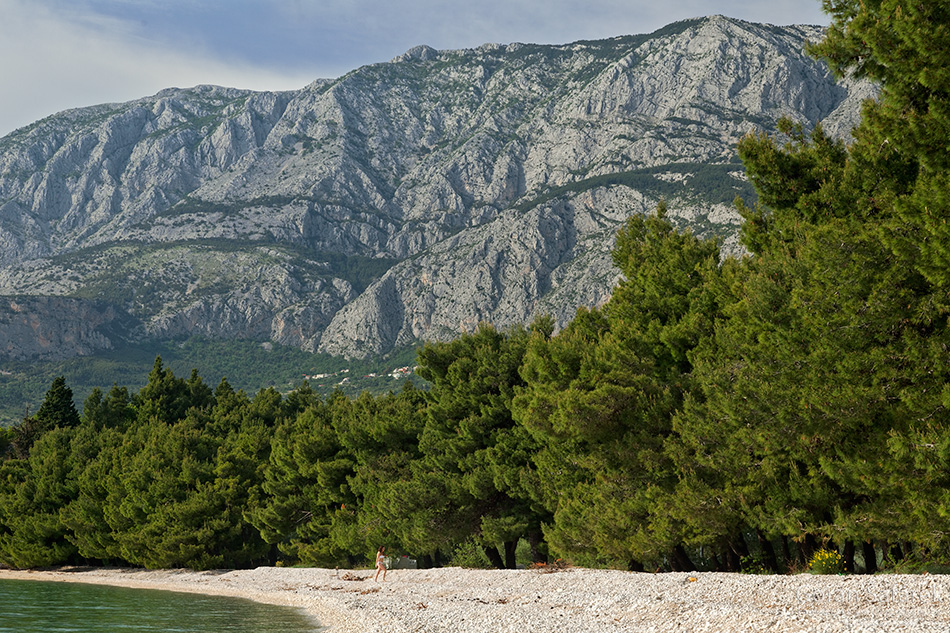
🏔 Dalmatian Mountains: Stark, Sunny, and Spectacular
Besides Biokovo, a rugged chain of karst mountains stretches along the Dalmatian coast—wild, exposed, and often overlooked. These are not high peaks by alpine standards, but their steep ascents and unrelenting sun make them challenging and rewarding for seasoned hikers.
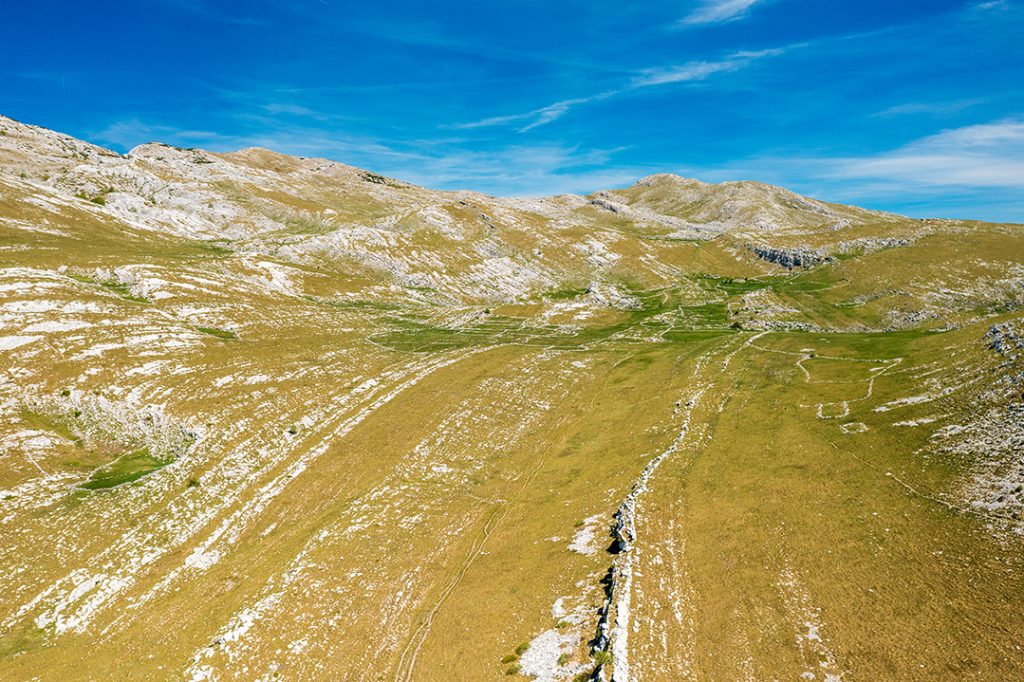
The Dalmatian mountains are part of the Dinaric Alps, carved from limestone, with little forest cover and almost no permanent water sources. This makes them unforgiving in summer—but in spring, autumn, or winter, they transform into peaceful, panoramic escapes.
⛰ Dinara (1,831 m)
- Croatia’s highest mountain, located near Knin
- The summit is called Sinjal
- Known for its wide views, dry meadows, and sense of remoteness
- There’s a mountain hut in Brezovac for staging the climb
- Best climbed in spring or autumn—never in the midday summer sun
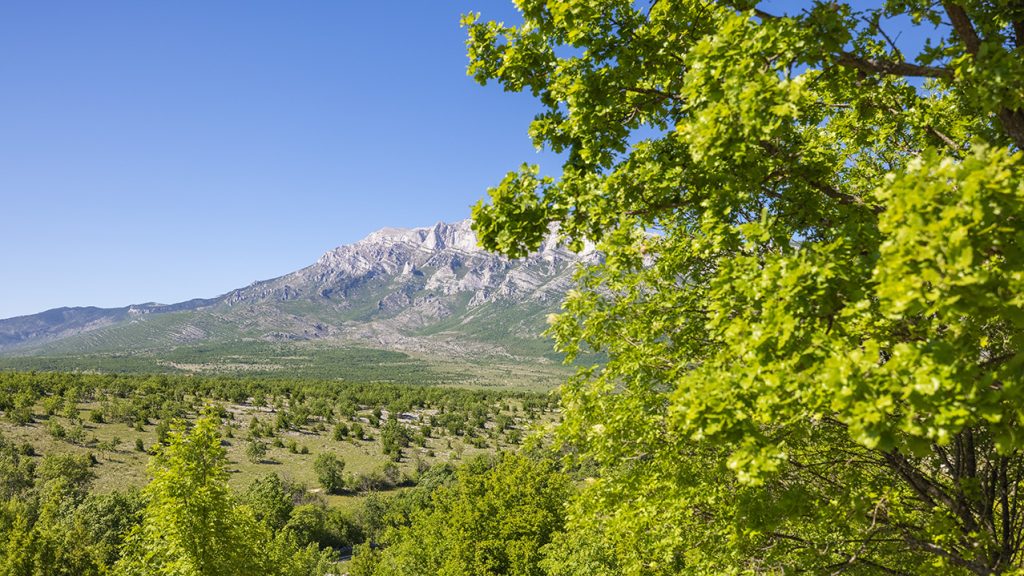
🪨 Mosor
- Towering over Split, this is the go-to mountain for locals
- Jagged ridges, dry grasslands, and a sprinkling of pine groves
- The Umberto Girometta mountain hut (near Sitno Gornje) offers shelter and refreshments
- Views stretch from the islands to the mountains of Bosnia
- Accessible by public transport—a rare perk in Croatian mountain hiking
🏞 Omiška Dinara
- Steep cliffs rising directly above the town of Omiš
- Short but intense hiking routes, with incredible views over the Cetina River canyon and the Adriatic
- No facilities, minimal shade—early starts are essential in summer
- Popular for day hikes and rock climbing
Hiking Tip:
These mountains are scorched in summer, with temperatures regularly topping 35°C. Start at dawn, bring plenty of water, and avoid exposed hikes in the heat.
Hiking on Croatian Islands: Small Peaks, Big Views
Croatia’s islands might not boast high altitudes, but what they lack in elevation, they make up for in scenery. With mountains rising directly from the sea, these trails offer breathtaking vistas, Mediterranean landscapes, and rewarding half-day hikes that are perfect for combining with a beach holiday.
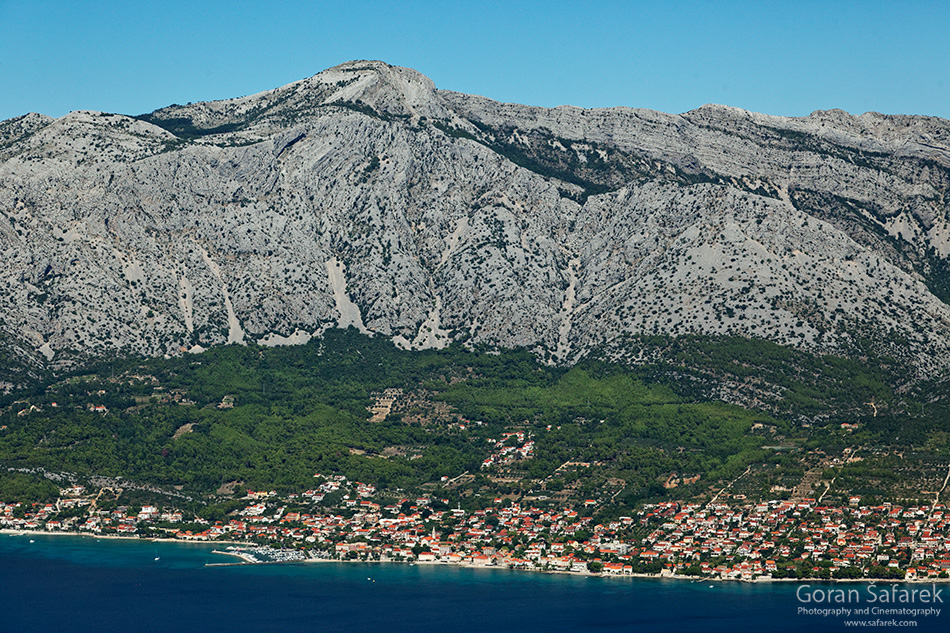
⛰ Sveti Ilija – Pelješac Peninsula (961 m)
Though technically on a peninsula, Sveti Ilija feels like an island hike. Towering over Orebić, it’s the highest peak of southern coastal Croatia, offering jaw-dropping views of the Adriatic islands, Mljet, Korčula, and the Pelješac channel.
- Starting point: Orebić, or halfway by car
- Difficulty: Moderate to challenging
- Best for: Panoramic sunrise hikes over Dalmatia
🏔 Osoršćica – Lošinj & Cres (588 m)
This scenic ridge rises dramatically over the sea between Mali Lošinj and Osor. It’s one of the best island hikes for combining history, geology, and vistas.
- Trailheads: Osor or Nerezine
- Don’t miss: The historic chapel ruins, a small cave, and the view toward the Velebit mountains on the mainland
- Ideal for: Sunset hikes and photo lovers
🌅 Vidova Gora – Brač Island (778 m)
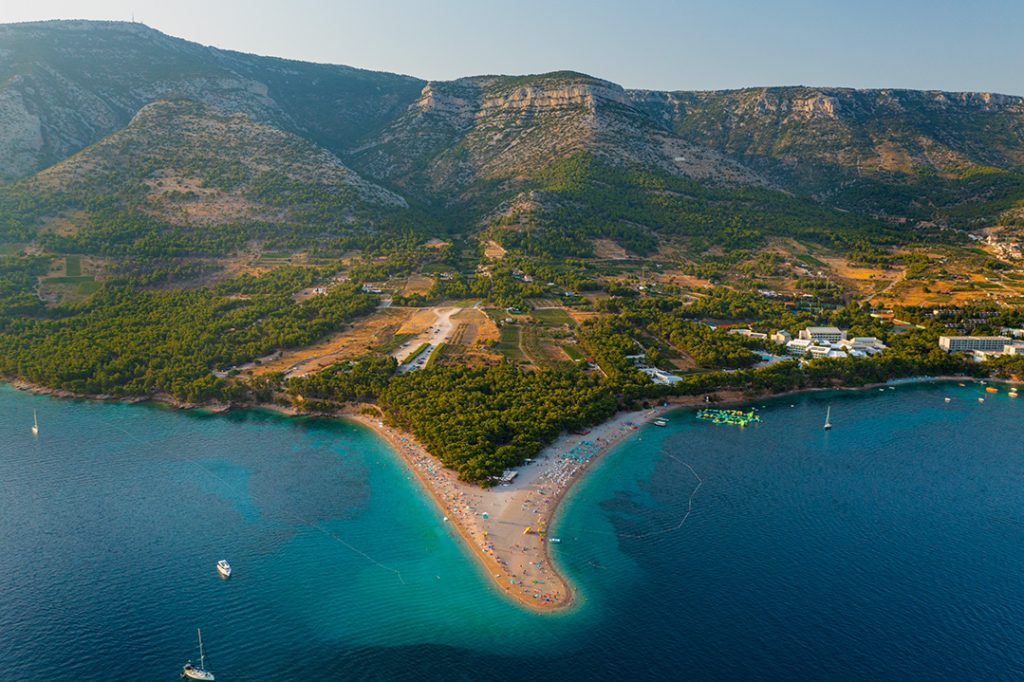
The highest island peak in the Adriatic, Vidova Gora is a must for anyone visiting Brač. The view from the top stretches over Zlatni Rat beach, Hvar, and all the way to Vis on clear days.
- Trailhead: Bol (trail starts behind the village)
- Features: Well-marked path through pine forest, limestone outcrops, and panoramic viewpoints
- Good to know: You can also drive up via a back road if short on time
🌄 Sveti Nikola – Hvar Island (628 m)
Hvar’s highest peak, Sveti Nikola, offers a peaceful escape from the island’s lively towns. The hike weaves through old terraces, pine forest, and rocky slopes before reaching the summit cross and chapel.
- Trailhead: Dol or Sveta Nedjelja
- Difficulty: Moderate, with some steep sections
- Reward: Spectacular views over the southern cliffs of Hvar and toward Italy on a clear day
🌞 Island Hiking Tips:
Check ferries and transport if hiking from a different island or mainland
Always start early—shade is scarce
Bring more water than you think you’ll need
Trails can be rocky—wear proper shoes
🌳 Hiking in Continental Croatia: Gentle Trails & Forest Escapes
While continental Croatia may not rival the rugged drama of Velebit or Biokovo, it still offers peaceful, scenic hikes—perfect for those looking to combine nature, culture, and comfort. Think rolling hills, dense forests, charming villages, and inviting mountain huts—all within easy reach of the country’s interior cities.
🏞 Medvednica – Zagreb’s Backyard Mountain
Just a tram ride away from the capital, Medvednica is Zagreb’s go-to escape for hikers, runners, and families. Its highest peak, Sljeme (1,035 m), is reachable via multiple forested trails of varying difficulty. In winter, it doubles as a small ski resort.
- Trailheads: Gračani, Mihaljevac, or Šestine
- Highlights: Dense beech forests, Medvedgrad fortress, cozy mountain huts like Grafičar and Puntijarka, and a year-round buzz of local hikers
- Tip: Combine a morning hike with a hearty local meal at a hut
🌄 Samoborsko Gorje – Hills of Charm and Vineyards
Just 30 minutes from Zagreb, the hills around Samobor are a mosaic of meadows, woodlands, and traditional villages. This is central Croatia’s hiking gem, especially in spring and autumn.
- Base town: Samobor, a picturesque Baroque town with excellent food and coffee culture
- Trails: Radiate from the town into the surrounding Samoborsko gorje
- Atmosphere: Friendly, laid-back, and perfect for half-day or full-day hikes followed by a meal and wine tasting
- Best for: Hikers who like to mix nature with good food and a touch of culture
🌲 Papuk – Forested Wilderness of Eastern Croatia
In the heart of Slavonia, Papuk Nature Park is one of the best-kept hiking secrets in the country. While mostly forested and gentle, it offers a wild feel and surprising geological variety—it’s even a UNESCO Geopark.
Family-friendly: Trails are not demanding, and facilities are well-developed
Top highlight: Jankovac Forest Park – home to a serene lake, waterfall, historic ruins, and a lovely mountain hut with restaurant
Best for: Nature lovers, forest hikers, and anyone traveling through Slavonia or Baranja
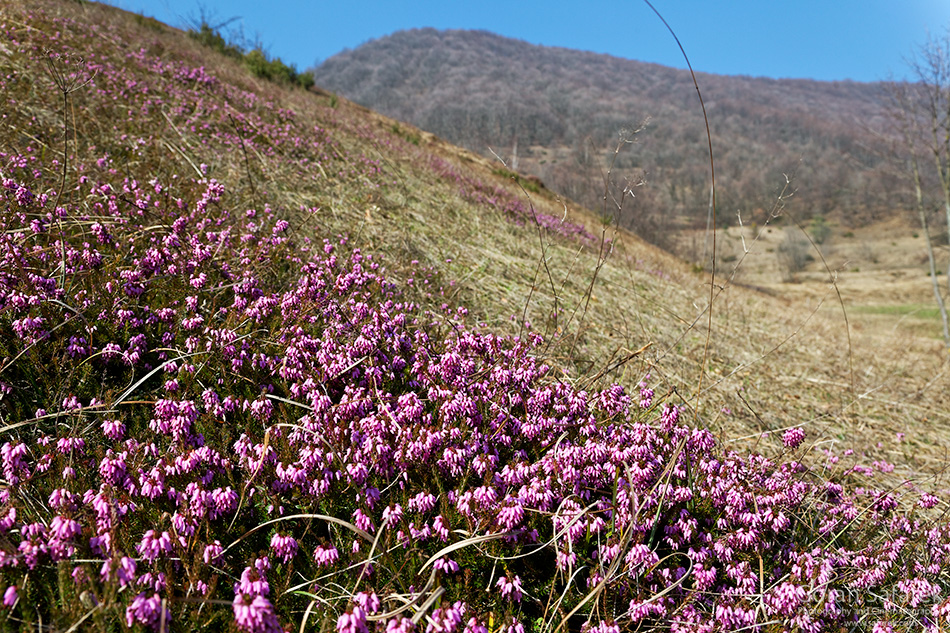
Goran Šafarek, biologist, author of several books and films about Croatia. Don’t forget to follow us on our Instagram, Twitter and Facebook
